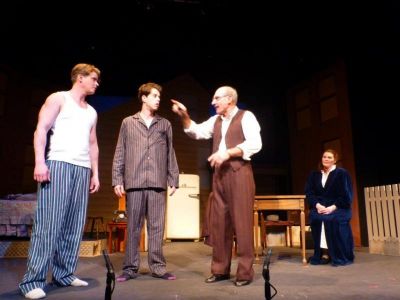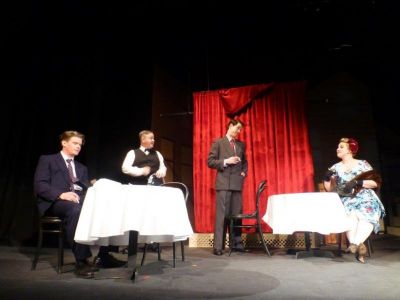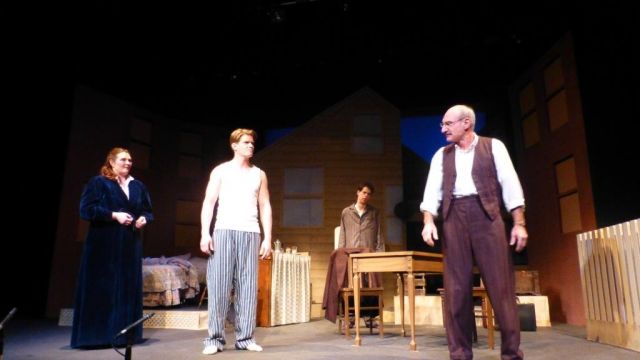Death of a Salesman
Death of a Salesman is Arthur Miller’s most famous and powerful play, premiering in 1949. Its title role has been played by everyone from Dustin Hoffman to Brian Dennehy. Even at 50 years old it ferociously analyses conflict in a family, in particular the relationship of father and son, together with the larger issues of capitalism and the demise of the American Dream.
The play follows the last days of Willy Loman’s life. He is a salesman, one who travels throughout New England and doesn't bring home commissions sufficient to support his family. Willy believes feverishly in the promise of the American Dream and the idea that by being ‘attractive’ and ‘liked’ we can succeed in life. In order to perpetuate this, Willy lies to himself and his family and lives in a world of illusion.
Sue Wylie has drawn together a team of very experienced actors in this current production at the Arts Theatre. There are some moments of power and brilliance where the story grabs the audience and asks that “attention must be paid”.
At curtain up we see a stark set, the colour palette of which is reflective of the urban claustrophobia of Willy’s existence. Set designer Nick Spottiswood has cleverly shown the drab brown of the city, with Willy’s home being closed in all around by apartments. This aptly fits Willy’s description, “There’s not a breath of fresh air in the neighborhood. The grass don’t grow any more, you can’t raise a carrot in the back yard. They should’ve had a law against apartment houses.”
 Death of a Salesman can be a difficult play to stage because of the constant mingling of flashbacks and present reality. The changing mix of states, however, needs to be clear to the audience. This production, directed by Sue Wylie, left me confused at times as I found the delineation of the time sequences often unclear. Attempts have been made to keep transitions fluid but there needed to be more focused lighting changes to delineate time and place. The lighting and back screen projection, by Richard Parkhill is good overall but more specific lighting states could have been used to more sharply show dream states vs reality vs flashbacks. The appearance of the ghost of Willie’s dapper, successful older brother Ben, played with gentlemanly presence by Greg Janzow in coloured lighting was however, quite effective.
Death of a Salesman can be a difficult play to stage because of the constant mingling of flashbacks and present reality. The changing mix of states, however, needs to be clear to the audience. This production, directed by Sue Wylie, left me confused at times as I found the delineation of the time sequences often unclear. Attempts have been made to keep transitions fluid but there needed to be more focused lighting changes to delineate time and place. The lighting and back screen projection, by Richard Parkhill is good overall but more specific lighting states could have been used to more sharply show dream states vs reality vs flashbacks. The appearance of the ghost of Willie’s dapper, successful older brother Ben, played with gentlemanly presence by Greg Janzow in coloured lighting was however, quite effective.
Willy Loman is portrayed by David Grybowski. Visually, David is the epitome of Willy Loman. It is, however, only at the start of play that we see the body language and vocalisation of a man exhausted with his life situation. I felt that whilst his performance was strong and passionate, the emotional development of his character could have been better paced. More light and shade in the character was needed. We saw much of the angry and frustrated Willy, but we needed to see his vulnerability and exhaustion more. However, overall, Grybowski is a clever performer, with a strong presence and his technique of using his open hands to symbolise seeking approval or applause is clever and effective.
Cate Rogers, also an experienced, intuitive actor, seemed a little young for the role of Linda at first, but this was soon forgotten as she brought a subdued quiet assurance to the character. As Willy’s champion, however, it is this reviewer’s opinion that she was a little too passive in some scenes that required Linda to speak with conviction and heart- rending devotion.

Willy’s two sons are played convincingly by Adam Tuominen (Biff) and Mark Healy (Happy). Healey is strong vocally and convincing as a philanderer. His transitions to a younger and older Happy are excellent. Adam Tuominen is a standout, however, in this play. His excellent physicality vividly shows the undercurrent of his tortured relationship with his father. The confrontation scenes between Biff and Willy are passionate and convincing on the part of both actors. The scene in Boston where Biff finds out about his father’s womanising reduced this reviewer to tears- heart wrenching and intuitively played by Tuominen. An outstanding performance and the highlight of the play for me.
Supporting actors are all strong. Tom Carney believably played Willie’s faithful friend Charley and Thorin Cupit is good as his unfeeling new boss Howard. Erin Walsh and Megan Langford are effective as two giggly, crafty floozies. Heath Trebilcock as the nerdy and brainy Bernard is excellent - particularly as an adult and Carol Lawton brings realism to the small role as Willy’s dalliance.
Physical scene changes in the play are simple but effective - using blinds or cloth to delineate the office and restaurant. The changes done like a New York street traffic scene are very effective. The transitions between ages of the two boys are excellent - both showing great physicality by the actors and excellent use of costume. The final car crash scene, whilst achieving its goal of telling us of Willy’s death, is, I feel, a little too brief and semi comical.
Gilian Cordell and Ian Rigney’s costuming and Mary Formosa’s props are impressive with attention to detail. Hair styles by Megan Langford are also very stylish and time accurate.
Therry has a strong production with some excellent performances. Death of a Salesman is a passionate and powerful play which is tricky to stage given its switching time and dream states, but Sue Wylie has done a solid job in bringing it to life.
Shelley Hampton
Subscribe to our E-Newsletter, buy our latest print edition or find a Performing Arts book at Book Nook.

